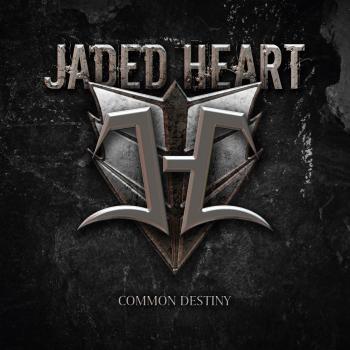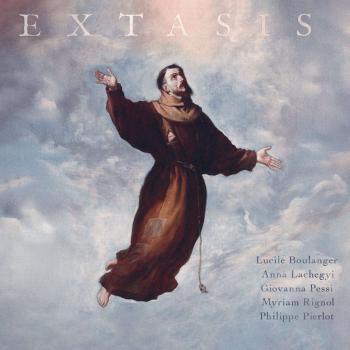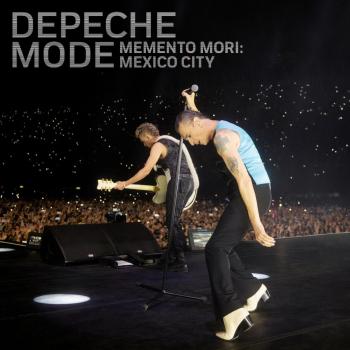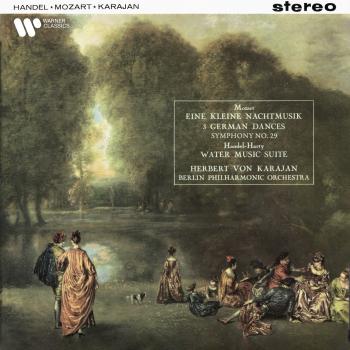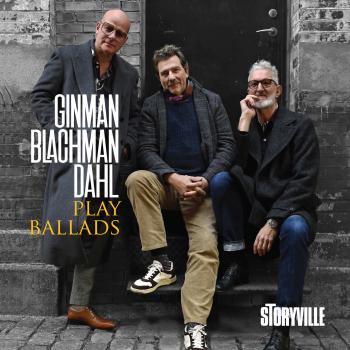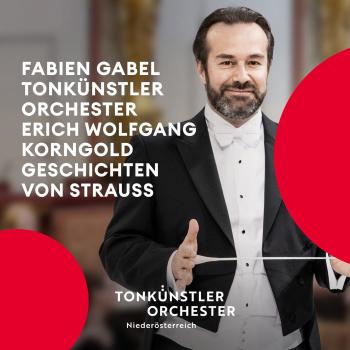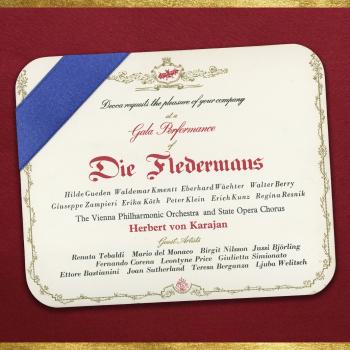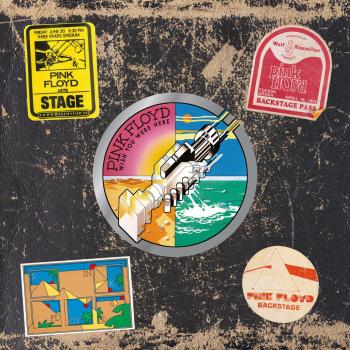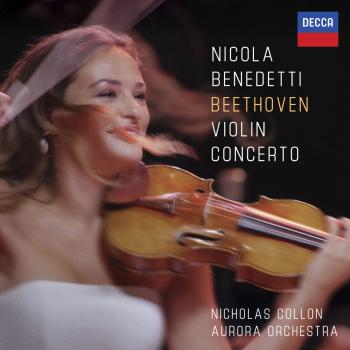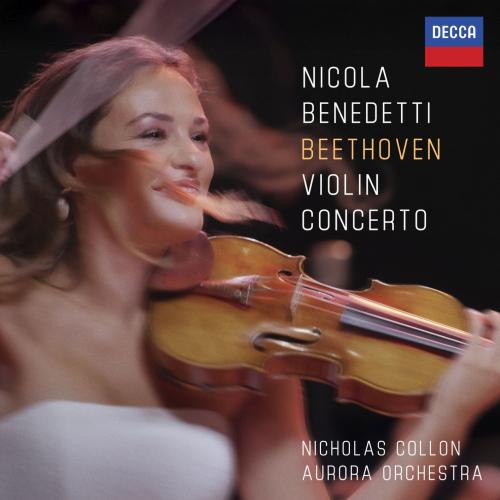
Beethoven: Violin Concerto Nicola Benedetti, Aurora Orchestra, Nicholas Collon
Album info
Album-Release:
2025
HRA-Release:
11.04.2025
Label: Decca Music Group Ltd.
Genre: Classical
Subgenre: Concertos
Artist: Nicola Benedetti, Aurora Orchestra, Nicholas Collon
Composer: Ludwig van Beethoven (1770–1827)
Album including Album cover
I`m sorry!
Dear HIGHRESAUDIO Visitor,
due to territorial constraints and also different releases dates in each country you currently can`t purchase this album. We are updating our release dates twice a week. So, please feel free to check from time-to-time, if the album is available for your country.
We suggest, that you bookmark the album and use our Short List function.
Thank you for your understanding and patience.
Yours sincerely, HIGHRESAUDIO
- Ludwig van Beethoven (1770 - 1827): Violin Concerto in D Major, Op. 61:
- 1 Beethoven: Violin Concerto in D Major, Op. 61: I. Allegro ma non troppo (Cadenza: Benedetti & Limonov) 23:09
- 2 Beethoven: Violin Concerto in D Major, Op. 61: II. Larghetto 09:06
- 3 Beethoven: Violin Concerto in D Major, Op. 61: III. Rondo. Allegro (Cadenza: Benedetti & Limonov) 08:48
Info for Beethoven: Violin Concerto
Nicola Benedetti is to release a major work of the violin repertoire, Beethoven's Violin Concerto. Recorded with Nicholas Collon and the award-winning Aurora Orchestra, who celebrate their 20th anniversary this year, the entire concerto was filmed to create a dynamic, full-length video. Plans for the video will be unveiled in due course. As well as a GRAMMY winner, 2 x Classical BRIT Award winner, BBC Music Magazine’s 2021 Personality of the Year and a CBE, Nicky runs the incredible Benedetti Foundation for young musicians, and in 2022 became the first ever female director of the world-famous Edinburgh International Festival. This will be her 12th album for Decca Classics.
This is a recording of a piece that emerges out of the urgency of the performances that inspired it, and as Nicola Benedetti says, to “try to approach this music with freshness of heart and mind”.
Benedetti further comments, “The solo line of this concerto was born out of an improvisatory spirit, with a lightness of touch soon to be out of fashion, with a virtuosity of integrity and poise. Many of us violinists grew up with such unhealthy reverence towards Beethoven, which soon turns into fear and an unnatural approach to his music. It can damage our ability to notice and embrace his humour, his wildness, and perhaps more importantly, the depth and power of his relationship to improvisation.”
Beethoven’s original piano version of the first movement cadenza was rearranged and adapted by Petr Limonov.
In the first movement, the music is based on the cadenza that Beethoven wrote for his own arrangement of this Violin Concerto as a Piano Concerto. Beethoven approached it in a truly revolutionary way by incorporating a timpani part into the texture, turning his cadenza into a dialogue between the pianist and the timpanist. Benedetti and Limonov felt that attempts to transcribe Beethoven’s bravura broken octaves and chromatic scales for violin in a literal way sounded too forceful for the otherwise lyrical and inward-looking nature of the piece. It gradually became clear that the cadenza needed re-writing, being true to Beethoven’s spirit, but not necessarily the letter. Usage of the timpani in a solo cadenza was as unusual at that time as it is now, so the harmonic progression leading up to it had to be unusual as well. Beethoven went around the full circle of fifths in a daring brush-stroke, employing highly sophisticated enharmonic techniques in a very subtle way as if to deliberately confuse the listener, leading him or her away from the established classical sense of tonality and preparing the ground for the timpani entry. Having started the cadenza with the same B-flat major chord as in Beethoven’s version, Benedetti and Limonov then emulated that unusual harmonic progression on the violin, albeit with a texture very different from Beethoven’s piano writing, allowing them to emphasise the element of surprise at the point of timpani entry, played on this recording by Henry Baldwin. It ensured that Beethoven’s original proportions stayed intact without making the violin writing resemble a transcription of a piano piece.
Benedetti continues, “The violin only actually plays thematic material for a few bars in the whole concerto. The rest flies free with fluidity, ornamenting the central themes played elsewhere.” Benedetti has a beautifully quixotic image for what it feels like to perform in this musical space: “like a little pixie burrowing their way through a maze, in all directions. Without the structure of the maze, it’s not nearly so fun to race around.”
The 23 minutes of the first movement create a long-breathed outpouring of sheer tunefulness, interrupted only by that wild cadenza. The slow movement is still more daringly spare, putting the soloist in an outer space of song, in another realm from the orchestra, connected to it only by tendrils and atmospheres of sound; a dream that melts into a finale whose joyfulness plants us back on the earth. Or does it? For Benedetti, the whole concerto is staged in a place of freedom, in which its musical essentials of grace and lyricism become transcendent features of a new kind of violin concerto. “I think of it looking upwards with its optimism: and of course, optimism is always most powerful in the face of adversity. That’s the Beethoven that breaks our heart and tears at our soul. But he always keeps us looking upwards, he always gives us hope.”
Nicholas Collon, Principal Conductor, Aurora Orchestra commented, ‘Since 2014, Aurora has pioneered the performance of major orchestral works from memory, but this is the first occasion on which we have undertaken the process for an instrumental concerto. Beethoven’s violin concerto was the perfect work with which to explore this approach: the orchestral accompaniment is truly symphonic in scope, and the interplay between orchestra and soloist is so rich and multi-layered. Creating an audio recording of a piece from memory raises an interesting question; does the memorised approach translate to a non-visual format? Our recording sessions in Alexandra Palace Theatre came off the back of hugely joyful live performances, in which we felt we discovered a new sense of freedom, truly exploring the symphonic nature of the score and trying to throw off the usual constraints of ‘accompanying,’ whilst also sensing a deeper communication with Nicky’s fabulous solo part. In performance and recording we placed the woodwind at the front of the orchestra, next to Nicky, for the ravishing 2nd movement, in which they ‘converse’ so closely with the violin solo. In the first movement cadenza, Nicky moved near to her duet partner – the timpani – and handed over to the bassoon solo for it to lead into the final coda. In the recording itself we tried to imagine we were making a performance in front of an audience, making longer takes than usual, an approach which feels quite natural when there is no music in place. Of course, one of the key differences of playing from memory is a visual one – both in terms of communication between players and communication between players and audience. Whilst this has to be left to the listener’s imagination, I do hope that some of the depth of commitment and love that all the players involved gave to the piece transmits to this album.’
Nicola Benedetti, violin
Aurora Orchestra
Nicholas Collon, conductor
Nicola Benedetti
Hilary Finch wrote in The Times, “it was thrilling to hear and watch Nicola Benedetti in a truly risk-taking performance that lived so much in the body and fused the sinews of the violin and the nerve-system of the player.” This sums up Nicola’s ability to communicate and enthrall audiences with dynamic and energy-filled performances. And whilst she is a highly sought performer on the world platform, Nicola is also fiercely dedicated to music education. Through her work with such organisations as Sistema Scotland, she has helped to demonstrate the power that music can have in transforming the lives of young people.
Highlights of Nicola’s 2011/12 season include her debut with the London Symphony Orchestra at the Enescu Festival in Bucharest and with the Netherlands Radio Philharmonic, San Francisco Symphony, Zurich Chamber, Cincinnati Symphony, Detroit Symphony and Hallé orchestras. She will also perform Brahms’ Double Concerto for Violin and Cello with Leonard Elschenbroich and the London Philharmonic Orchestra under the baton of Christoph Eschenbach and has recently participated in a highly publicized New York Philharmonic performance in Central Park with Alan Gilbert conducting. Later in the season, Nicola will also perform a series of four recitals at LSO St. Luke’s in London for the BBC, as well as give recitals at the Wigmore Hall, in Baden Baden and in Wiesbaden. She will make her Concertgebouw debut with the Mantova Chamber Orchestra and will perform multiple times with the Stuttgart Philharmonic Orchestra, Scottish Chamber Orchestra, and on a multi-city tour of the UK with the Royal Philharmonic Orchestra. She also embarks on a tour of South America that takes her to major concert halls in cities such as Buenos Aires (Teatro Colon), Rio de Janeiro, Montevideo and Lima.
In recent seasons, Nicola has previously performed multiple times with the Philharmonia, Royal Scottish National, Royal Philharmonic Orchestra, BBC Scottish Symphony and Czech Philharmonic Orchestras as well as the Royal Liverpool Philharmonic and City of Birmingham Symphony orchestras. She has also worked with the Deutsche Symphony Orchestra in Berlin, Tonhalle Orchestra in Zurich, Bournemouth Symphony, Orchestre Philharmonique de Montpellier, Russian National Orchestra, Het Brabants Orkest, KBS Symphony and Japan Philharmonic as well as the Dallas, Chicago, Pittsburgh, San Francisco, Indianapolis, Toronto and Vancouver symphony orchestras and the National Arts Centre Orchestra in Ottawa. Nicola’s busy schedule has seen her work with conductors such as Vladimir Ashkenazy, Jakub Hrusa, Louis Langree, Alan Gilbert, Stéphane Denève, Andrew Litton, Sir Neville Marriner, Kristjan Jarvi, Paavo Jarvi, Mikhail Pletnev, Donald Runnicles, Yan Pascal Tortelier, Mario Venzago, Diego Matheuz, Pinchas Zukerman and Jaap van Zweden.
Nicola made her debut at the Proms in 2010, and has performed at the Tivoli Festival in Copenhagen and the Echternach Festival in Luxembourg and was a featured artist at the Istanbul Festival in 2011. She has given recitals in London, Edinburgh, Glasgow, Hong Kong, Paris, Sacile, New York, Boston and Washington D.C. In July 2011, Nicola made her South American debut with the Simon Bolivar Symphony Orchestra of Venezuela, Diego Matheuz conducting, and during her week-long visit, she taught numerous masterclasses with the revolutionary El Sistema program.
Nicola performs in chamber music concerts with her regular trio, both in the UK and further afield. Along with cellist Leonard Elschenbroich and pianist Alexei Grynyuk, she has performed at the Ravinia Festival, LSO St Luke’s, Istanbul Festival, Schloss Elmau, and West Cork Chamber Music Festival. Nicola has also played chamber music at the Verbier Festival, the Moritzburg Festival, the Tuscan Sun Festival in Cortona with Jean Yves Thibaudet, at Lockenhaus and at Prussia Cove.
Throughout her career, Nicola’s desire to perform a broad variety of repertoire and reach a wide audience has shown her to be one of Britain’s most innovative and creative young violinists. Nicola’s choice of the Szymanowski Violin Concerto for the BBC Young Musician of the Year in 2004 was just the beginning of her focus on less-often programmed repertoire. She has recorded newly commissioned works by John Tavener and James Macmillan, worked on jazz-influenced repertoire with Wynton Marsalis and others, and explored authentic baroque performance, her studies of which have culminated in the release of her first recording on the Decca Classics label in 2011/2012; a disc of baroque violin masterpieces by Vivaldi, Tartini and Veracini entitled ‘Italia’.
Nicola is also widely respected for her commitment to working with young people. Since 2005, she has visited schools throughout the United Kingdom in conjunction with the CLIC Sargent Practice-a-thon, in which she encourages pupils of all ages to pick up their instruments and enjoy classical music. In 2010, she became involved in El Sistema Scotland’s Big Noise project, a music initiative partnered with Venezuela’s El Sistema (Fundación Musical Simón Bolívar). As a Board Member and the program’s official musical “Big Sister”, Nicola makes regular visits to Raploch, Scotland to conduct master classes and work closely with the children.
Winner of the Classical BRIT Award for Young British Classic Performer in 2008, Nicola has previously released five CDs with Universal/Deutsche Grammophon, the most recent featuring Tchaikovsky and Bruch concerti with the Czech Philharmonic Orchestra and Jakub Hrusa. Nicola’s debut album included Szymanowski, Saint-Saëns, Massenet and Brahms with the London Symphony Orchestra, followed by a second release featuring works by Mendelssohn, Mozart, Schubert and Macmillan with the Academy of St. Martin in the Fields. Nicola’s third album was comprised of newly commissioned works by Tavener and Vaughan Williams’ The Lark Ascending with the London Philharmonic Orchestra and the fourth featured works by Sarasate, Fauré, Rachmaninov, Pärt and Ravel.
Born in Scotland of Italian heritage, Nicola began violin lessons at the age of five. In 1997, she entered the Yehudi Menuhin School, where she studied with Natasha Boyarskaya. After leaving the Yehudi Menuhin School, she continued her studies with Maciej Rakowski and then Pavel Vernikov, and continues to work with multiple acclaimed teachers and performers.
Nicola plays the Gariel Stradivarius (1717), courtesy of Jonathan Moulds.
This album contains no booklet.

